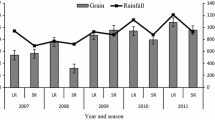Abstract
Locally occurring Minjinju phosphate rock (MPR) in direct application as P source for maize production was compared with water-soluble imported, processed triplesuperphosphate (TSP) in a field study over three seasons on ten important, low-fertility agricultural soils throughout sub-humid to humid Tanzania. Except for the first season, where MPR was slightly inferior to TSP, direct application of MPR gave the same yields as TSP indicating that MPR can replace TSP on acid, severely weathered tropical soils low to very low in available P and exchangeable Ca and with high to very high phosphate adsorption capacity. Similar response for granulated and non-granulated MPR enables replacement of the dusty finely powdered MPR by the user-friendly granulated form. However, P fertilization improved maize yields on only three soils because plant growth is also limited by other factors than P, such as frost (one site) and lack of water and other nutrients, e.g. B, Cu and Mg. Apart from saving foreign currency, replacement of TSP by MPR has additional advantages because MPR contains calcium carbonate (lime effect), Mg, K, Cu and Zn. On the other hand, economy constrains MPR use as MPR was found to be economically competitive with TSP only in areas within about 700 km from the mine, mainly because of current very high transportation costs.
It may therefore be concluded that despite clear advantages of replacing TSP by MPR, climatic, economic and nutritional constraints must be dealt with in order to ensure improved and sustainable crop yields through use of MPR in direct application in Tanzania.

Similar content being viewed by others
References
Bolan NS, White RE, Hedley MJ (1990) A review of use of phosphate rocks as fertilizers for direct application in Australia and New Zealand. Aust J Expt Agric 30:297–313
Borggaard OK, Elberling B (2004) Pedological biogeochemistry. Paritas Grafik A/S, Brøndby
Borggaard OK, Szilas C, Gimsing AL, Rasmussen LH (2004) Estimation of phosphate adsorption capacity by means of a pedotransfer function. Geoderma 11:55–61
Buol SW, Southard RJ, Graham RC, McDaniel PA (2003) Soil Genesis and Classification, 5th edn. Iowa State Press, Ames
Chien SH, Hammond LL (1978) A simple chemical method for evaluating the agronomic potential of granulated phosphate rock. Soil Sci Soc Am J 42:615–617
Chien SH, Menon RG (1995). Factors affecting the agronomic effectiveness of phosphate rock for direct application. Fert Res 41:227–234
De Pauw E. (1984) Soils, physiography and agroecological zones in Tanzania. Ministry of Agriculture, Dar-es-Salaam, Tanzania/FAO, Rome
FAO (1990) Guidelines for soil description, 3rd edn. Food and Agriculture Organization of United Nations, Rome
Friesen DK, Rao IM, Thomas RJ, Oberson A, Sanz JL (1997) Phosphorus acquisition and cycling in crop and pasture systems in low fertility tropical soils. Plant Soil 196:289–294
Guidry MW, Mackenzie FT (2003) Experimental study of igneous and sedimentary apatite dissolution: Control of pH, distance from equilibrium, and temperature on dissolution rates. Geochim Cosmochim Acta 67:2949–2963
Hart MR, Quin BF, Nguyen ML (2004) Phosphorus runoff from agricultural land and direct fertilizer effects: a review. J Environ Qual 33:1954–1972
Hammond LL, Chien SH, Mokwunye AU (1986) Agronomic value of unacidulated and partially acidulated phosphate rocks indigenous to the tropics. Adv Agron 40:89–140
ISSS Working Group RB (1998) In: Deckers JA, Spargaren OC, Nachtergaele FO (eds) World reference base for soil resources. ISRIC-FAO-ISSS, Arcco, Leuven
Lisuma JB, Semoka JMR, Semu E (2006) Maize yield response and nutrient uptake after micronutrient application on a volcanic soil. Agron J 98:402–406
MAFS (2002) Economic assessment of Minjingu phosphate production and use at farm level. Ministry of Agriculture and Food Security (MAFS), Agriculture Sector Support Programme, Draft Report, February 2002
Marschner H (1995) Mineral Nutrition of Higher Plants, 2nd edn. Academic Press, London
Mnkeni PNS, Semoka JMR, Buganga BBS (1991) Effectiveness of Minjingu phosphate rock as a source of phosphorus for maize in some soils of Morogoro, Tanzania. Zimbabwe J Agric Res 29:27–37
Msollas MM, Semoka JMR, Borggaard OK (2005) Hard Minjingu phosphate rock: an alternative P source for maize production on acid soils in Tanzania. Nutr Cycl Agroecosyst 72:299–308
Mwambete I (1991) Tanzanian fertilizer mineral deposits. Fert Res 30:181–185
Rajan SSS, Watkinson JH, Sinclair AG (1996) Phosphate rock for direct application to soils. Adv Agron 57:77–159
Semoka JMR, Mnkeni PNS, Ringo HD (1992) Effectiveness of Tanzanian phosphate rocks of igneous and sedimentary origin as sources of phosphorus for maize. Zimbabwe J Agric Res 30:127–136
Sikora FJ (2002) Evaluating and quantifying the liming potential of phosphate rocks. Nutr Cycl Agroecosyst 63:59–67
Smalberger SA, Singh U, Chien SH, Henao J, Wilkens PW (2006) Development and validation of a phosphate rock decision support system. Agron J 98:471–483
Szilas C (2002) The Tanzanian Minjingu phosphate rock – possibilities and limitations for direct application. PhD Thesis, Royal Veterinary and Agricultural University, Copenhagen (http://www.igv.kvl.dk/∼casz)
Szilas C, Møberg JP, Borggaard OK, Semoka JMR (2005) Mineralogy of characteristic well-drained soils of sub-humid to humid Tanzania. Acta Agric Scand Sect B 55:241–251
Vance CP, Uhde-Stone C, Allan DL (2003). Phosphorus acquisition and use: critical adaptations by plants for securing a nonrenewable resource. New Phytol 157: 423–447
Van Straten P (2002) Rocks for crops. Agrominerals of Sub-Saharian Africa. ICRAF, Nairobi
Acknowledgement
Financial support from Danida (Danish Development Agency) is greatly acknowledged.
Author information
Authors and Affiliations
Corresponding author
Rights and permissions
About this article
Cite this article
Szilas, C., Semoka, J.M.R. & Borggaard, O.K. Can local Minjingu phosphate rock replace superphosphate on acid soils in Tanzania?. Nutr Cycl Agroecosyst 77, 257–268 (2007). https://doi.org/10.1007/s10705-006-9064-4
Received:
Accepted:
Published:
Issue Date:
DOI: https://doi.org/10.1007/s10705-006-9064-4




